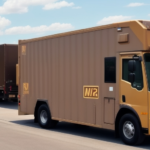Understanding UPS Tracking Shipping Rates
If you're a business owner or frequently send and receive shipments, having a reliable shipping carrier is crucial. UPS (United Parcel Service) is a leading shipping carrier, serving over 220 countries and territories worldwide. Renowned for its exceptional tracking services and delivery speed, UPS handles millions of packages daily. However, with numerous shipping options and varying rates, navigating the UPS system can be challenging. This article provides a comprehensive overview of UPS tracking shipping rates, helping you make informed decisions for your shipping needs.
What is UPS Tracking?
Before diving into shipping rates, it's essential to understand UPS Tracking. This service allows you to monitor the delivery status of your shipments in real-time. With UPS Tracking, you can see when your package was shipped, its current location during transit, and the estimated delivery time. According to UPS, their tracking system ensures over 99% package visibility, enhancing reliability for both senders and recipients.
One significant benefit of UPS Tracking is the peace of mind it offers. You can be confident that your package is on its way and receive notifications about any delays or delivery issues. Additionally, UPS Tracking provides flexibility to modify delivery preferences, such as redirecting a package to a different address or rescheduling delivery times based on your availability.
For businesses, UPS Tracking delivers critical data for supply chain management. By analyzing delivery times and shipment patterns, businesses can identify areas for improvement, optimize their logistics, and ultimately reduce costs while enhancing customer satisfaction. According to a 2023 UPS survey, businesses that effectively utilize tracking report a 15% increase in customer satisfaction due to improved delivery transparency.
The Basics of Shipping Rates
Shipping rates represent the cost associated with sending a package from one location to another. Several factors influence these rates, including the package's weight and dimensions, the travel distance, and the chosen shipping service.
Additionally, shipping rates may fluctuate based on the time of year and any special promotions or discounts offered by UPS. For example, shipping rates during the holiday season can be up to 20% higher due to increased demand. Some services provide extra features like insurance or advanced tracking for an additional fee. Therefore, carefully evaluating all factors is essential to ensure you're getting the best value for your shipping needs.
How UPS Determines Shipping Rates
UPS calculates shipping rates based on the package's weight and dimensions, the distance it must travel, and the selected shipping service. Generally, larger and heavier packages incur higher shipping costs. UPS offers a variety of shipping services—including ground, air, and international—which each have distinct rates. International shipping rates, in particular, are approximately 3 to 5 times higher than domestic rates due to longer distances and additional handling required.
Delivery time is another critical factor affecting shipping rates. UPS provides various delivery options, such as standard, expedited, and express services, each with different pricing structures. Customers requiring faster delivery pay a premium for these expedited services. For instance, UPS Next Day Air typically costs 50-100% more than UPS Ground, depending on the shipment's origin and destination.
UPS also offers supplementary services like insurance, signature confirmation, and special handling, which can influence the total shipping rate. These add-ons enhance security and convenience but come at an additional cost. According to UPS, adding insurance for high-value items can add approximately $2-$5 per package depending on the coverage amount.
Factors That Affect UPS Shipping Rates
Several elements can impact UPS shipping rates, including:
- Package Dimensions and Weight: Heavier and larger packages cost more to ship. UPS uses dimensional weight pricing for packages, which takes into account both size and weight to determine rates. For instance, a package with larger dimensions but lighter weight might be priced based on its dimensional weight.
- Service Type: Ground, air, and international services have different pricing. UPS Ground is generally the most cost-effective for domestic shipments, whereas UPS Air services like EXPRESS are priced higher due to faster delivery.
- Destination Address: Shipping to residential addresses may be more expensive than to businesses. For example, UPS residential surcharges can add anywhere from $2 to $4 per package.
- Seasonal Demand: Rates can increase during peak seasons like holidays due to higher shipping volumes. It's not uncommon for shipping rates to spike by up to 30% during peak periods.
- Package Contents: Fragile or hazardous items may require special handling, leading to additional fees. Shipping perishable goods also involves higher rates due to the need for expedited delivery and temperature control.
Understanding these factors enables businesses and individuals to estimate shipping costs accurately and select the most cost-effective options.
Additionally, UPS offers volume discounts for frequent shippers, which can significantly reduce shipping costs for businesses with high shipping volumes. According to a 2023 UPS report, businesses shipping over 5,000 packages annually could see up to 25% savings with volume discounts.
The Different Types of UPS Shipping Services
UPS provides a range of shipping services tailored to various needs, including:
- UPS Ground: The most affordable option for domestic shipments, offering reliable delivery within 1-5 business days across the U.S., Canada, and Puerto Rico.
- UPS 3 Day Select: Guaranteed delivery within three business days, ideal for non-urgent but time-sensitive shipments.
- UPS 2nd Day Air: Delivers by the end of the second business day, balancing speed and cost for faster delivery needs.
- UPS Next Day Air: Expedited service ensuring next-day delivery by specific times, suitable for urgent shipments.
- UPS Freight: Suitable for large, heavy, or bulky shipments, offering less-than-truckload (LTL) and full truckload (FTL) options.
- UPS International Services: Covers shipments to over 220 countries and territories with various speed options, including UPS Express Saver and UPS Worldwide Expedited.
Selecting the appropriate service depends on factors like urgency, budget, and destination, allowing flexibility to meet different shipping requirements. For comprehensive information, visit the UPS Shipping Services page.
How to Calculate Your UPS Shipping Costs
To accurately calculate your UPS shipping costs, consider the following steps:
- Determine Package Weight and Dimensions: Accurately measure and weigh your package to ensure precise rate estimates. UPS provides guidelines on package dimensions and weight.
- Select Shipping Service: Choose the appropriate UPS service based on delivery speed and cost considerations. Evaluate services like UPS Ground for standard shipping and UPS Next Day Air for urgent shipments.
- Identify Destination: Enter the origin and destination addresses to calculate distance-related costs. International shipping will include additional customs fees and taxes.
Use the UPS online shipping calculator to estimate shipping costs before generating a shipping label. Comparing different services and their associated costs will help you find the most economical option that meets your delivery timeline.
For instance, if timely delivery is critical, you might opt for UPS Next Day Air, whereas UPS Ground offers a more cost-effective solution for non-urgent shipments.
Tips for Saving Money on UPS Shipping Rates
Maximizing cost efficiency when shipping with UPS is achievable through several strategies:
- Select Slower Shipping Services: Opt for ground shipping or other less expedited options to reduce costs. UPS Ground can save up to 30% compared to air services.
- Utilize Discounts and Promotions: Take advantage of UPS discounts, promotions, or loyalty programs available for frequent shippers. Businesses may qualify for negotiated rates based on shipment volume.
- Use Third-Party Shipping Platforms: Some third-party companies offer lower rates by negotiating better deals with UPS, potentially reducing shipping costs by 10-15%.
- Optimize Packaging: Reducing package weight and dimensions can significantly decrease shipping costs by lowering the dimensional weight charges.
- Consolidate Shipments: Combining multiple packages into a single shipment can take advantage of UPS's volume discounts, potentially saving up to 20% on shipping fees.
- Adopt UPS Smart Pickup: Scheduling regular pickups eliminates manual scheduling and ensures timely pickup, potentially reducing costs and saving valuable time.
Understanding the Importance of Package Weight and Dimensions
The weight and dimensions of your package are pivotal in determining shipping rates. Accurate measurement and weighing prevent overpayment for shipping and avoid unexpected fees due to discrepancies. UPS employs dimensional weight pricing, which considers both the size and weight of a package to calculate rates.
Moreover, lighter and smaller packages are often more environmentally friendly. Shipping companies, including UPS, are increasingly prioritizing sustainability by encouraging smaller, lighter packages to reduce fuel consumption and carbon emissions. According to UPS's 2023 sustainability report, optimizing package size and weight can help reduce their carbon footprint by up to 15% annually.
Additionally, manageable package sizes enhance the safety and security of shipments. Smaller, lighter packages are easier to handle, reducing the risk of damage or loss during transit. Ensuring your packages are appropriately sized and weighted helps guarantee they arrive safely and intact.
Common Reasons for Shipping Rate Discrepancies
Shipping rate discrepancies can arise from several sources:
- Inaccurate Package Measurements: Incorrect weight or dimension data can lead to additional fees or package returns. It's essential to measure and weigh each package accurately using calibrated scales and measuring tools.
- Selected Shipping Method: Choosing expedited or premium services over standard shipping can result in higher costs. Ensure the selected shipping method aligns with your delivery needs to avoid unnecessary expenses.
- Longer Shipping Distances: Greater distances between origin and destination naturally escalate shipping rates. Consolidating shipments or optimizing delivery routes can help mitigate distance-related costs.
- Special Handling Requirements: Shipping fragile, hazardous, or oversized items necessitates special packaging and handling, incurring extra charges. Always declare the nature of the contents to UPS to ensure appropriate packaging and handling.
- International Shipping: Cross-border shipments involve customs fees, taxes, and extended handling, contributing to higher rates. Understanding customs regulations and correctly classifying your goods can help manage these costs effectively.
Accurate package preparation and selecting the appropriate shipping method can mitigate these discrepancies, ensuring transparency and predictability in shipping costs.
How to Use UPS Tracking to Monitor Your Package's Delivery Status
To effectively use UPS Tracking, you'll need a tracking number, found on your shipping label or receipt. Enter this number into the UPS tracking tool available on their website or mobile app to view your package's real-time delivery status. This feature provides updates such as when your package was shipped, its transit points, and the estimated delivery date.
Additionally, UPS offers delivery alerts, allowing you to receive notifications via email or text message when your package is out for delivery or has been delivered. These alerts are particularly useful if you're unavailable to receive the package, ensuring you can arrange for alternate delivery options if necessary.
It's important to note that UPS provides varying levels of tracking detail depending on the service chosen. For example, UPS Next Day Air offers more comprehensive tracking information compared to UPS Ground. Selecting the appropriate service based on your tracking needs and budget is essential for optimizing your shipping experience.
In conclusion, understanding UPS tracking shipping rates can save both time and money when shipping packages. By leveraging UPS’s comprehensive tracking tools and selecting the most cost-effective shipping services, you can ensure efficient and reliable delivery for your shipments.





















